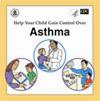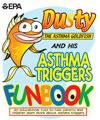Publications about Asthma
Publications for Parents, Caregivers and Kids

Help Your Child Gain Control Over Asthma
This brochure offers tips on how to manage asthma and follow simple steps to minimize exposure to asthma triggers found indoors and out.
Help Your Child Gain Control Over Asthma[EPA 402-F-04-021]

Asthma Prevention Tri-fold
This brochure offers actions you can take to help manage your child's asthma and prevent attacks before they happen. Learn how managing your child's indoor environment is an important step in reducing exposure to the things that can trigger asthma attacks.
How to Manage Your Child's Indoor Environment

Clearing the Air: 10 Steps to Making Your Home Asthma-Friendly
This one page, simple to follow guidance document lists recommended actions to help control asthma triggers in the home. Clearing the Air: 10 Steps to Making Your Home Asthma-Friendly[EPA 402-F-04-017].

Dusty The Asthma Goldfish and His Asthma Triggers Funbook
This educational activity book helps children learn more about asthma triggers.
Dusty The Asthma Goldfish and His Asthma Triggers Funbook[EPA 402-F-04-008]

Why is Coco Orange?
Coco the chameleon can't change colors, and his asthma is acting up. Read how Coco and his friends at Lizard Lick Elementary solve this mystery as they learn about air quality and how to stay healthy when the air quality is bad. This picture book is for all children, especially those with asthma, and their caregivers.
Why is Coco Orange?

Clear Your Home of Asthma Triggers: Your Children Will Breathe Easier
This brochure is a handy resource for parents and caregivers of children with asthma. It explains common indoor asthma triggers and how to control them in homes.
Clear Your Home of Asthma Triggers: Your Children Will Breathe Easier[EPA 402-F-99-005].
Publications for Healthcare Professionals
Asthma Home Environment Checklist [EPA 402-F-03-030]
This checklist guides home care visitors in identifying environmental asthma triggers most commonly found in homes. It includes sections on the building, home interior and room interior and provides low-cost action steps for remediation.
In-Home Environmental Education Program, Case Study: Children's Hospital of Philadelphia
The Children's Hospital of Philadelphia case study is intended to offer providers, health insurers, public health departments and community-based organizations an overview of an asthma in-home intervention.
Implementing an Asthma Home Visit Program: 10 Steps to Help Health Plans Get Started[EPA 402-K-05-006]
This guide offers health care organizations step-by-step instructions on how to start an asthma home visit program, with emphasis on environmental risk factor management. Representatives from seven health care plans share their experiences and recommendations.
Publications for Schools
Managing Asthma in the School Environment[EPA 402-K-10-004]
This guide offers valuable information for all school staff, especially school nurses, teachers and maintenance staff, on how to identify and control common environmental factors in schools that trigger asthma episodes.
IAQ Tools for Schools Action Kit
Shows schools how to carry out a practical plan to improve indoor air problems at little or no cost using straightforward activities and in-house staff. The kit provides best practices, industry guidelines, sample policies and a sample IAQ management plan. Get the entire Kit online at theIAQ Tools for Schools Action Kit website.
Factsheets and Reports
2016 Asthma Fact Sheet
Highlights the most up-to-date asthma statistics.
Presidential Task Force on Environmental Health and Safety Risks to Children
The President's Task Force on Environmental Health Risks and Safety Risks to Children developed the Coordinated Federal Action Plan to Reduce Racial and Ethnic Asthma Disparities, which is an outcome of the collaborative interagency Asthma Disparities Working Group, co-chaired by HHS, EPA and HUD.
Clearing the Air: Asthma and Indoor Air Exposures
The National Academy of Sciences Institute of Medicine issued this report in 2000 describing the role of indoor environmental pollutants in the development and exacerbation of asthma. The report concludes that exposure to indoor pollutants is an important contributor to the asthma problem in this nation. Asthma sufferers should consult with their doctor about reducing their exposure indoor air pollutants.
Download the Highlights of the Conclusions of the NAS Report. A full copy of the NAS report is available at the National Academies Press website. Exit
Other EPA Publications
For additional information on Indoor Air Quality topics and resources, see our Indoor Air Publications site.
You can order Indoor Air Quality publications from EPA's National Service Center for Environmental Publications (NSCEP)
Phone: 1-800-490-9198
Fax: (301)-604-3408
Email: NSCEP (nscep@lmsolas.com). Use the EPA Document Number when ordering from NSCEP.
Asian Language Publications
Clear Your Home of Asthma Triggers: Your Children Will Breathe Easier. This brochure is a handy resource for parents and caregivers of children with asthma. It explains common indoor asthma triggers and how to control them in homes.
- Chinese[EPA 402-F-99-005A]
- Korean[EPA 402-F-99-005C]
- Vietnamese[EPA 402-F-99-005B]
